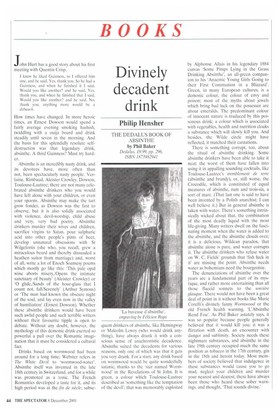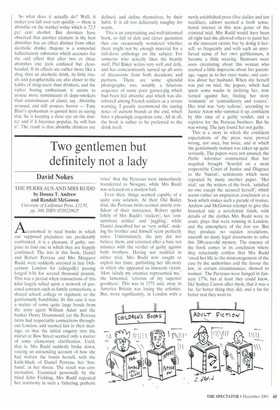Divinely decadent drink
Philip Hensher
THE DEDALUS BOOK OF ABSINTHE by Phil Baker Dedalus, £9.99, pp. 296, ISBN 1873982941 John Hurt has a good story about his first meeting with Quentin Crisp.
I knew he liked Guinness, so I offered him one, and he said, Yes, thank you. So he had a Guinness, and when he finished it I said, Would you like another? and he said, Yes, thank you, and when he finished that I said, Would you like another? and he said, No, thank you, anything more would be a debauch.
How times have changed. In more heroic times, an Ernest Dowson would spend a fairly average evening smoking hashish, twiddling with a ouija board and drink steadily until seven in the morning. And the basis for this splendidly resolute selfdestruction was that legendary drink, absinthe. A third Guinness? Must try harder.
Absinthe is an incredibly nasty drink, and its devotees have, more often than not, been spectacularly nasty people. Verlaine, Rimbaud, Ale ister Crowley, Dawson, Toulouse-Lautrec; there are not many celebrated absinthe drinkers who you would have left alone with your children, or even your spoons. Absinthe may make the tart grow fonder, as Dawson was the first to observe, but it is also solidly associated with violence, devil-worship, child abuse and very, very had poetry. Absinthe drinkers murder their wives and children, sacrifice virgins to Satan, pour sulphuric acid into other people's pints of beer, develop unnatural obsessions with St Wilgefortis (she who, you recall, grew a miraculous beard and thereby dissuaded a heathen suitor from marriage) and, worst of all, write a lot of Enoch Soamesy poems which mostly go like this: 'This pale opal wine aborts misery,/Opens the intimate sanctuary of beauty' (Aleister Crowley) or '0 glide,/Sands of the hour-glass that I count not, fall/Serenely' (Arthur Symons) or The man had known the obscure night of the soul, and lay even now in the valley of humiliation' (Ernest Dowson). Whether these absinthe drinkers would have been such awful people and such terrible writers without their favourite tipple is open to debate. Without any doubt, however, the mythology of this demonic drink exerted so powerful a pull over the Romantic imagination that it must be considered a cultural fact.
Drinks based on wormwood had been around for a long time; Webster refers in The White Devil to 'wormwood-water'. Absinthe itself was invented in the late 18th century in Switzerland, and for a while was promoted as a tonic. The French Romantics developed a taste for it, and its high period was at the fin de siècle; subse quent drinkers of absinthe, like Hemingway or Malcolm Lowry (who would drink anything), have always drunk it with a conscious sense of anachronistic decadence. Absinthe suited the decadents for various reasons, only one of which was that it gets you very drunk. For a start, any drink based on wormwood would be quite wonderfully satanic, thanks to the 'star named Wormwood' in the Revelations of St John. It is green, a colour which Toulouse-Lautrec described as 'something like the temptation of the devil'; that was memorably exploited
by Alphonse Allais in his legendary 1884 canvas 'Some Pimps Lying in the Grass Drinking Absinthe', an all-green companion to his 'Anaemic Young Girls Going to their First Communion in a Blizzard'. Green, in many European cultures, is a demonic colour, the colour of envy and poison; most of the myths about jewels which bring bad luck on the possessor are about emeralds. The predominant colour of innocent nature is traduced by this poisonous drink; a colour which is associated with vegetables, health and nutrition cloaks a substance which will slowly kill you. And besides, the Wilde circle might have reflected, it matched their carnations.
There is something corrupt, too, about the ritual of absinthe drinking. Some absinthe drinkers have been able to take it neat; the worst of them have fallen into using it in appalling sounding cocktails, like Toulouse-Lautrec's tremblement de terre (absinthe and brandy), or, still worse, the Crocodile, which is constituted of equal measures of absinthe, rum and trois-six, a sort of mare. (That last one is said to have been invented by a Polish anarchist; I can well believe it.) But in general absinthe is taken with water. There's something intrinsically wicked about that, the combination of the most deadly liquid with the most life-giving. Many writers dwell on the fascinating moment when the water is added to the absinthe, and the absinthe clouds over; it is a delicious, Wildean paradox, that absinthe alone is pure, and water corrupts it. The absinthe drinkers who refuse water on W. C. Fields' grounds that 'fish fuck in it' are missing the point. Absinthe needs water as bohemians need the bourgeoisie.
The denunciations of absinthe over the years are a fundamental part of its mystique, and rather more entertaining than all those flaccid sonnets to the sorciere glauque. There would not have been a great deal of point in it without books like Marie Corelli's divinely funny Wormwood or the old French health warning. `L'Absinthe Rend Fou'. As Phil Baker astutely says, it was so popular because people generally believed that it would kill you; it was a flirtation with death, an encounter with danger and sublimity. Society needs these nightmare substances, and absinthe in the late 19th century occupied much the same position as tobacco in the 17th century, gin in the 18th and heroin today. Most members of society believed that indulgence in these substances would cause you to go mad, neglect your children and murder your nearest and dearest; there have always been those who heard these sober warnings, and thought, 'That sounds divine.'
So what does it actually do? Well, it makes you fall over very quickly — there is absinthe on the market today which is 72.5 per cent alcohol. But devotees have observed that another element in the best absinthes has an effect distinct from other alcoholic drinks; thujone is a somewhat hallucinatory substance which accounts for the odd effect that after two or three absinthes one feels confused but clearheaded. If its effects are rather more like a drug than an alcoholic drink, its little rituals and paraphernalia are also closer to the habits of drug-users than drinkers, and the rather boring enthusiasm it seems to arouse more reminiscent of dope-smokers than connoisseurs of claret, say. Absinthe aroused, and still arouses, horror — Tony Blair's spokesman is quoted here as saying that 'he is keeping a close eye on the matter and if it becomes popular, he will ban it'. The result is that absinthe drinkers are
defined, and define themselves, by their habit. It is all too deliciously naughty for words.
This is an entertaining and well-informed book, so full of deft and clever quotation that one occasionally wondered whether there might not be enough material for a full-dress anthology on the subject. For someone who actually likes the beastly stuff, Phil Baker writes very well and drily, and has conscientiously turned up all sorts of discussions from both decadents and puritans. There are some splendid photographs, too, notably a hilarious sequence of some poor guinea-pig which had been fed absinthe and which was distributed among French soldiers as a severe warning. I greatly recommend the tasting notes of current brands at the end, which have a pleasingly crapulous tone. All in all, the book is rather to be preferred to the drink itself.























































































 Previous page
Previous page